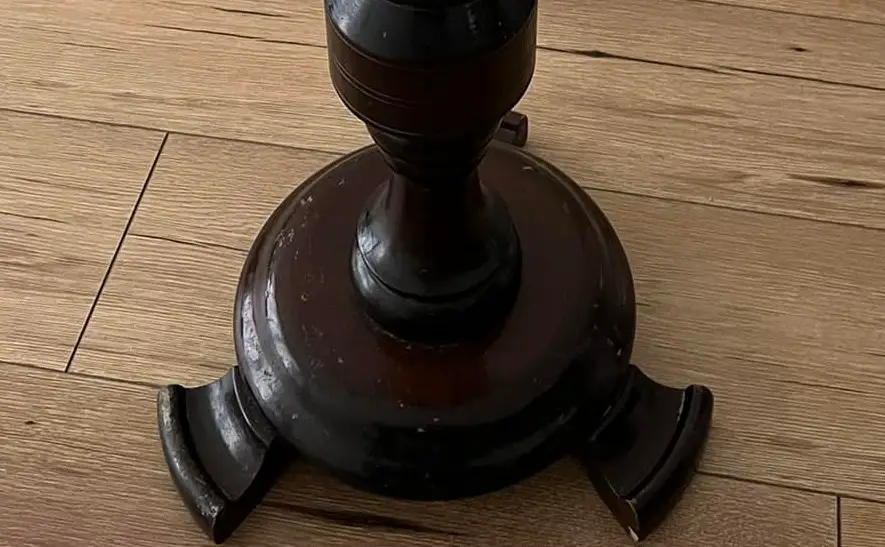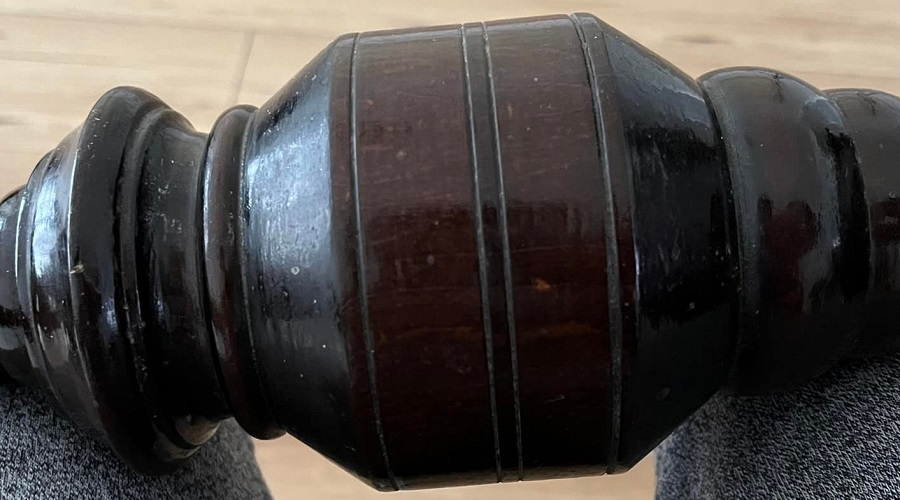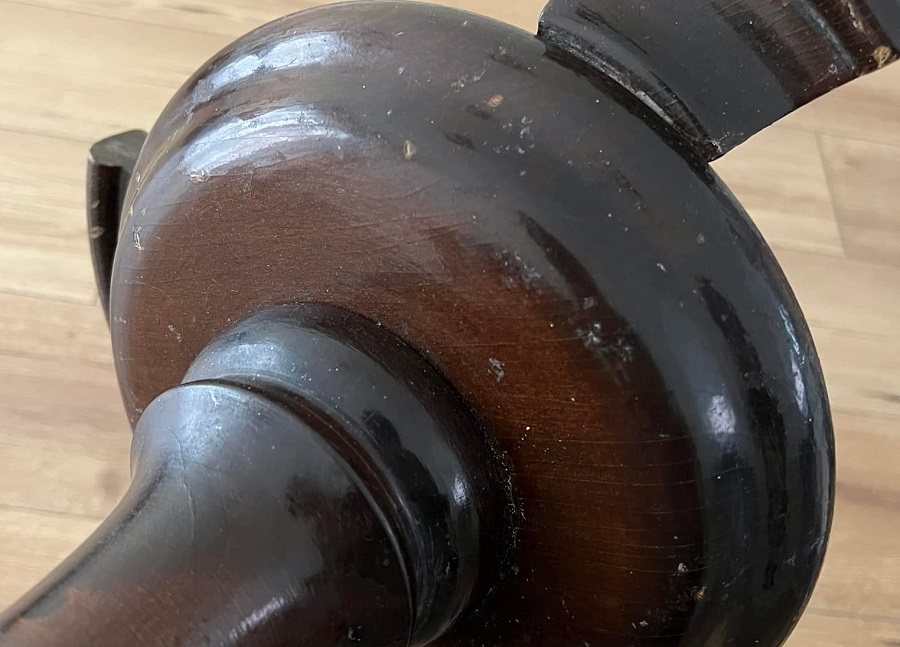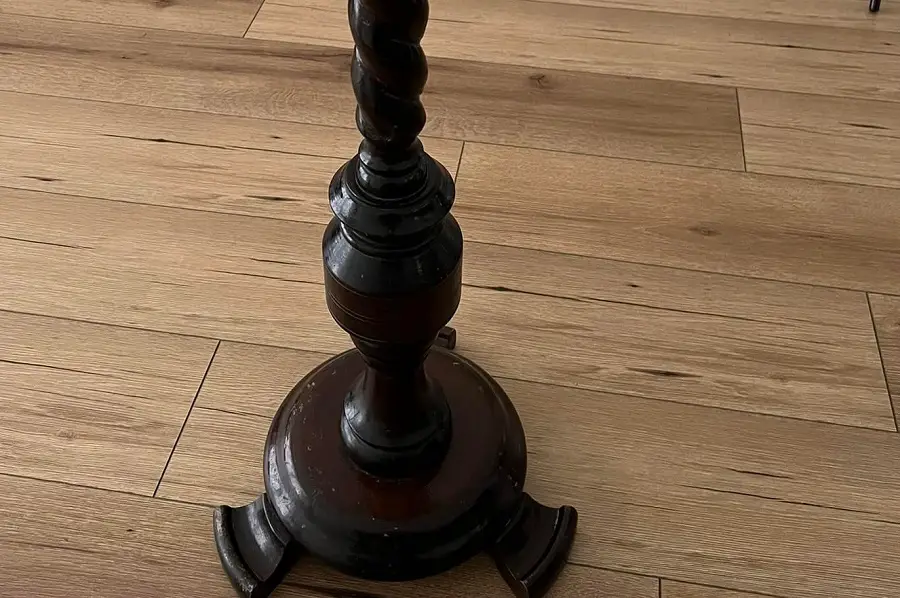I discovered the question on a profile group. Phrased a bit differently but you get the idea. At first glance it seemed simple, a light sanitizing and another coat of varnish, nothing complicated. Some of the people who rushed to answer actually went with this idea.
But a closer look at the photos shows that things are not so simple and the chandelier needs more attention. The owner of the chandelier mentioned in passing junk, there were some imperfections. On closer inspection, these imperfections were not very small, which meant that it could be worked on in many different ways, with different results.

A careful analysis of the photos revealed the real state of the streetlight
The photos were quite large so I was able to carefully analyze every detail of the chandelier. Here are the conclusions:
The chandelier wasn't its first refresh. The thick layer of varnish that covered it was an indication that the chandelier had been varnished over time. Colored varnish had been used and in some areas the wood was completely covered as if paint had been used. On closer inspection, it could be seen that it had not been cleaned very well before varnishing. In some areas, there was some denting under the varnish, but not to the wood.
The lake had extensive surface cracks. Especially at the bottom, the lake layer had visible cracks. They were definitely due to the thick layer of varnish, hence the presence especially at the bottom, where it collects more due to seepage. The cracks are not due to the natural movements of the wood because they do not follow the direction of the grain.
It had numerous dents that reached the wood (those light-colored marks). In many places it had dings that went all the way to the wood, the light color that appeared in those areas being evidence of this. There were also scratches or shallower dents that could be easily overlooked on an old piece, that is, they would not have been so disturbing that one would want to refinish it.
Tarnished areas that may show long-term maintenance with wax or products containing wax. The chandelier had been covered with glossy varnish so the tarnished areas were slightly visible. Dirt had collected there and diminished the shine considerably. My guess is that wax products had been used to wipe it off and so the dust and dirt had settled better.
What could be done? From my point of view there were two options, a simple one and a more complicated one, with more work.

A refresh that cannot remove all the shortcomings
The idea of the simple variant is to accept the appearance with some flaws, the value of the lamp being precisely the old appearance. It's exactly the refresh you want, in which case it's the dirt and odor that bothers, not the dents, scratches and cracks.
It is advisable to sanitize with water and detergent, possibly followed by light sanding, not thinner. The chandelier has most likely been varnished with gloss colored nitrocellulose varnish. This varnish is sensitive to thinner, it will rub off, further tarnish the appearance, and the gloss will be lost. Find here information on how to identify the product with which an old object has been finished.
Washing your furniture with water and detergent need not scare you. Indeed, it's not good to get water splashing on the wood, but we're not talking about hosing down or letting the dampness sit on the item for long. Wash your furniture with a washcloth soaked in lukewarm water with liquid dishwashing detergent (it's a very good degreaser). You can add a few drops of essential oils to the detergent water, mint and lemon are recommended for their fresh scent. Other ways to get rid of unpleasant odors from objects and furniture include here.
With a well squeezed cloth, vigorously clean every part of the object. If it has not been cleaned on the first pass, clean it again. DO NOT use abrasives as they are coarse and will scratch the surface.
After cleaning off the dirt, wipe the object again with a cloth soaked in clean water and wrung out well. Finally, wipe thoroughly with a clean, dry cotton cloth (unused cotton T-shirts are best) and leave to soak for at least 12 hours.
If the layer of dirt is thick and cannot be removed by washing alone, after sanding, the entire surface is lightly sanded with sandpaper with a grain size of 400 grit min. in order not to affect the gloss of the varnish.
After sanding or sanding and stripping, apply a colorless or walnut-colored furniture or wood wax to the entire surface. Antique walnut would be the most suitable color in this case. The colored wax also helps to partially cover any dings that have worked their way into the wood. Wax is also applied with a soft cotton cloth.
Leave for a minimum of half an hour (or as long as recommended by the manufacturer) then polish with a soft, clean cotton cloth. This will give a very nice satin sheen.

If you work on the lake, it's no longer resurfacing but refurbishment
You go the complicated route if you want to get rid of the cracks, but in this case it's not just a case of refreshing but of refurbishing the object. The cracks should not be covered with another coat of varnish because that will also crack as the layer will become thicker.
The first step is to remove the cracked varnish down to the wood. The simplest is to use a universal stripper. These are usually in gel form and applied with a brush. Or cloths soaked in thinner are placed over the entire surface of the chandelier. The cloth-wrapped object is placed in a bag. This avoids the smell of thinner, and the object is held in the atmosphere by thinner vapors, so the effect is quicker.
If the paint stripper is solvent-based, do the same to intensify the effect. After the varnish has swelled or soaked, clean with a squeegee (a squeegee). The surface is then wiped with thinner and sanded with 150 or 180-grit sandpaper. Find here the method described at length, but also other methods of removing old varnish or paint.
Once the wood is reached, walnut stain it and apply 2 coats of glossy colored nitrocellulose varnish (to reproduce the original look). For a uniform look, spray application is recommended. There is no need to worry about the initial unpleasant odor as it is removed with the old varnish coat, and the applied finish comes with a new furniture smell.

In conclusion
In short, the recommendations would be as follows:
- analyze the object thoroughly to uncover any problems,
- First of all, remove the accumulated dirt, that might be enough,
- do not apply varnish over dirt and under no circumstances over cracks. Do not apply polyurethane varnish over nitro varnish (I saw such a recommendation on the group), they are not compatible. Old objects are generally finished with shellac or nitrocellulose varnish, and recoating can be done with nitrocellulose varnish,
- On an old object, scratches and dents are not always a problem. They are accepted as part of the charm of the object,
- Wax can be used to refresh the old look, but only after they have been sanitized. Polished wax has a satin sheen. You can't get a mirror shine with wax,
- if you decide to remove old varnish, you should know that it is not easy. Choose this as a last resort and call in the professionals if you have never done this before. You may discover that it's hard along the way and abandon the project. The bad thing is that, by the time you abandon it, you may ruin it further.
I hope you find the information interesting. If you have any questions or queries, please leave them below in the space provided. I will certainly reply.




































Great article. It was also on point for me ... less to no experience.
I have a rather difficult situation for me, namely. I have a cherry tree with bark and all, about 180cm long and 20cm in diameter, cut for about 3 years of which in the last year it has been sitting on two bushes (not on the ground) and covered with plastic bags. I want to cut it up and make kitchen choppers, maybe use sawdust. Can you help me "get" the best out of it?
Thank you!
Thanks for your appreciation!
I hope no curries or other insects got into it. Usually logs are peeled immediately so you don't have such problems. Also, it should have been sliced into planks to dry faster. It is too thick to reach equilibrium moisture in such a short time.
Cherry wood is smooth and beautiful, more suitable for jewellery boxes than for shredders.
If you still want your shredder, you should cut it and leave it to dry further with the ends covered with paraffin solution or diluted primer to control the water outflow so it doesn't crack. Once it reaches equilibrium moisture, somewhere around 12-16% at natural drying, cut the shredder into the desired shape, sand it first with 80 or 100 grit sandpaper, then with 150 and 220, then apply 2 coats of mineral oil. It is inert, perfect for use in the kitchen. Mineral oil can be found in pharmacies. I leave below link about oiling shredders, cherry wood and drying wood (it's about drying walnut wood, but they are similar) I also put link with using wood for smoking. You can use cherry sawdust for smoking meats.
Good luck!
https://revistadinlemn.ro/2016/11/09/ciresul-lemnul-elegantei/
https://revistadinlemn.ro/2021/09/02/am-taiat-nucul-cum-il-usuc-sa-nu-crape/
https://revistadinlemn.ro/2017/07/04/uscarea-lemnului/
https://revistadinlemn.ro/2019/07/11/protejarea-vaselor-de-lemn-din-bucatarie-cu-materiale-netoxice/
https://revistadinlemn.ro/2021/12/13/specii-de-lemn-folosite-pentru-afumarea-carnii-pestelui-sau-legumelor-care-adauga-gust-si-savoare/